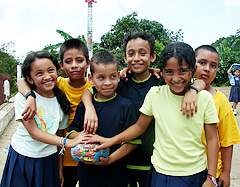 |
 |
 |
 Entertainment | September 2007 Entertainment | September 2007  
Small Countries, Great Films
 Diego Graglia - NYDailyNews.com Diego Graglia - NYDailyNews.com
go to original


| | "Pinta The Bird," a rare film from El Salvador. |
As the offer of Latin American-oriented cinema is increasing in New York City, Latinbeat has become a late-summer classic.

The annual series organized by the Film Society at Lincoln Center (www.filmlinc.com) holds its ground as a place to encounter the brightest and the latest of the region's cinema.

"People hold us to a high standard, and we're trying to live up to that," says Richard Peña, the Film Society's program director.

Apart from the ever-present selections from Brazil, Argentina, Mexico and Colombia, this year's edition — running Sept. 7-18 at the Walter Reade Theater — offers several films from countries where there's almost no movie industry to speak of, like Ecuador, Uruguay or Bolivia.

This is the case for Paz Encina's "Paraguayan Hammock," the first film to be produced in Paraguay in more than three decades, as well as the shorts "Pinta the Bird" (El Salvador) and "Temporal" (Costa Rica).

Peña says there was no explicit intention of showcasing usually underrepresented countries.

"We don't choose films because it's Ecuador or Paraguay," he says. "We choose the films because we think they are good films."

"How Much Further" ("Qué tan lejos"), which follows two young women on a road trip around Ecuador, surprisingly became the most popular local film there since 1990, according to director Tania Hermida.

"The movie has no commercial hook," she says in an E-mail. "It's a small film with an unconventional story and characters."

Another highlight will be the directorial debut of Mexican star Gael García Bernal, who also plays the lead role in his opera prima, "Déficit."

One theme that appears in several of this year's selections is Latin-American migration (mostly to the U.S.) and its consequences in the lives of migrants and their families.

"Soy Andina," by American director Mitch Teplitsky, follows the transnational lives of two female dancers: a Peruvian immigrant to New York and an American born to Peruvian parents.

"I was interested in the story of the immigrant community kind of living in both worlds and never feeling part of one or the other," Teplitsky says. After six years of work on the documentary, he ended up marrying a Peruvian woman he interviewed on camera.

"In the process, I kind of uprooted myself," he says. "I went through the same process" as the immigrants.

Tania Cypriano's "My Grandmother Has a Video Camera" covers more than two decades in the life of her Brazilian family in the United States. Patricia Riggen's "Under the Same Moon" is about a Mexican kid and his mother, who leave for the North. "The Most Beautiful of My Very Best Years," by Martín Boulocq, follows a Bolivian man as he tries to get money to exit his country.

A screening of Uruguay's "Whisky" (2004), by Juan Pablo Rebella and Pablo Stoll, will be dedicated to Rebella, who committed suicide last year. | 
 | |
 |



